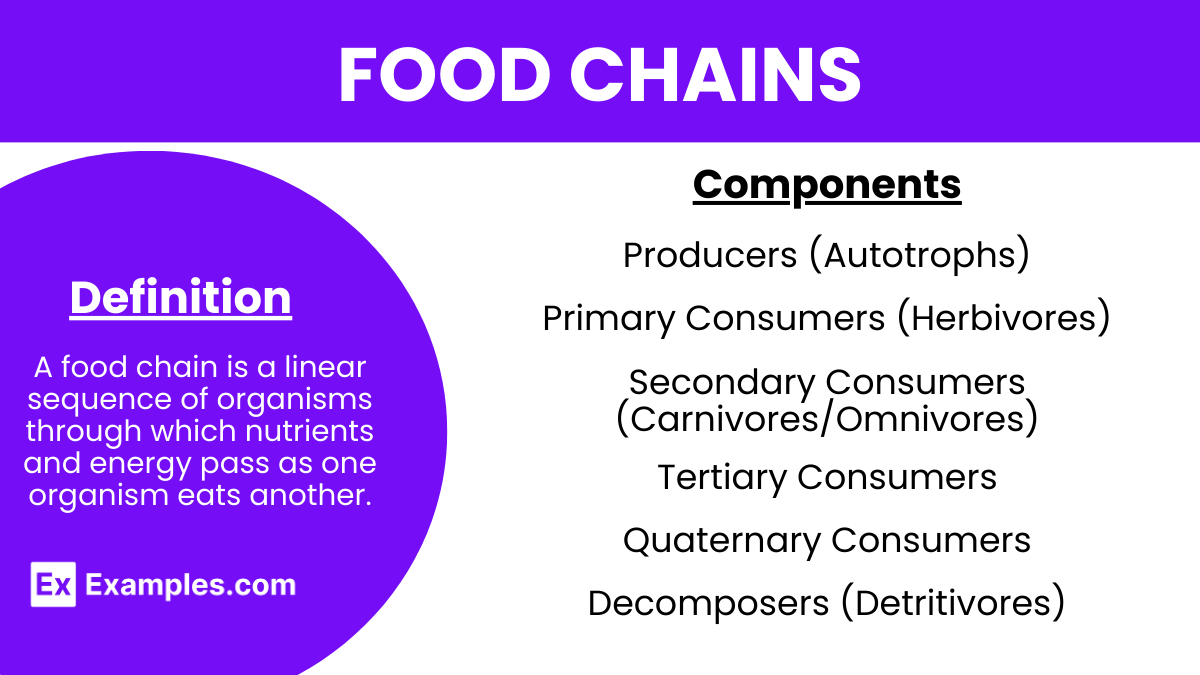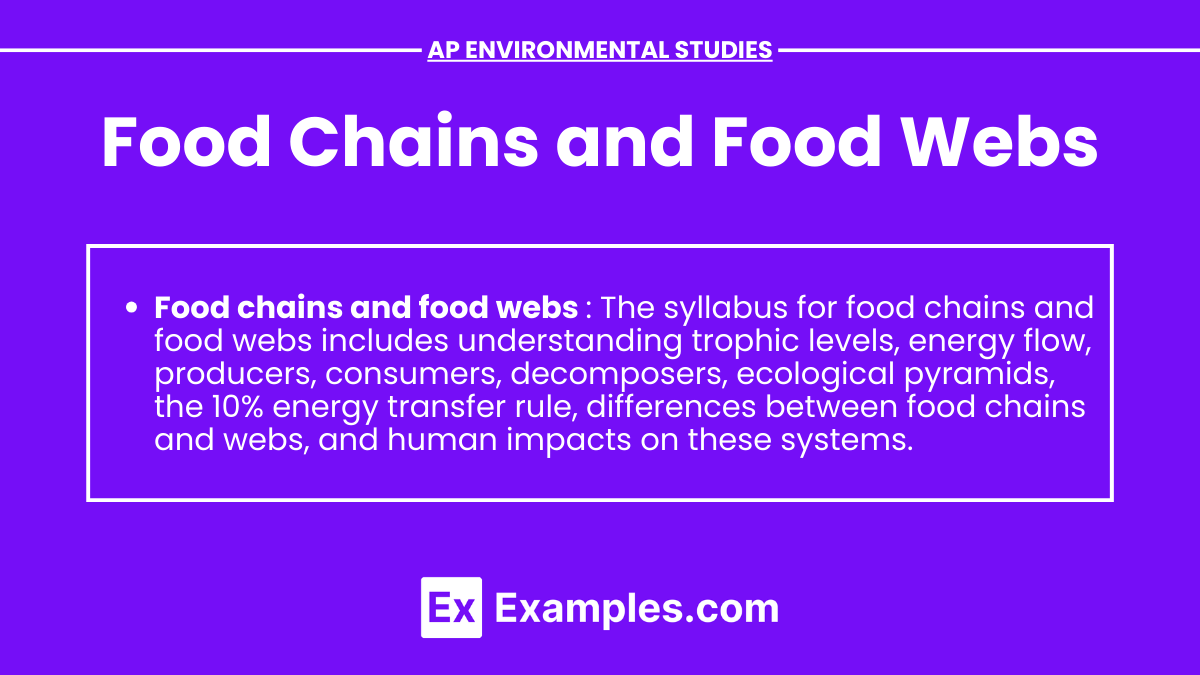Food chains and food webs are fundamental concepts in ecology that describe the flow of energy and nutrients through ecosystems. A food chain is a linear sequence showing how energy moves from producers, such as plants and algae, to various levels of consumers, including herbivores, carnivores, and omnivores, culminating in apex predators. In contrast, a food web is a more complex and realistic representation of an ecosystem, illustrating the intricate network of interconnected food chains and highlighting the interdependence of organisms. These concepts are crucial for understanding the balance and dynamics of ecosystems, the role of different species, and the impact of human activities on natural environments.
Learning objectives
For studying food chains and food webs include understanding the linear and interconnected pathways of energy and nutrient flow in ecosystems. Students should be able to identify and differentiate between producers, consumers, and decomposers, and recognize the significance of trophic levels. They should comprehend the 10% energy transfer rule, the structure of ecological pyramids, and the differences between grazing and detrital food webs. Additionally, students should analyze the impact of human activities on these systems, such as overfishing, habitat destruction, and pollution, and appreciate the complexity and interdependence of species within ecosystems.
Food Chains

Definition:
- A food chain is a linear sequence of organisms through which nutrients and energy pass as one organism eats another.
Components:
- Producers (Autotrophs):
- Organisms that produce their own food from sunlight (photosynthesis) or chemical energy (chemosynthesis).
- Examples: Plants, algae, some bacteria.
- Primary Consumers (Herbivores):
- Organisms that eat producers.
- Examples: Insects, rabbits, deer.
- Secondary Consumers (Carnivores/Omnivores):
- Organisms that eat primary consumers.
- Examples: Frogs, small fish, wolves.
- Tertiary Consumers:
- Organisms that eat secondary consumers.
- Examples: Hawks, sharks.
- Quaternary Consumers:
- Apex predators at the top of the food chain with no natural predators.
- Examples: Lions, eagles.
- Decomposers (Detritivores):
- Organisms that break down dead or decaying organisms.
- Examples: Fungi, bacteria, earthworms.
Energy Transfer:
- Energy is transferred from one trophic level to the next.
- Only about 10% of the energy is passed on to the next level (10% Rule), while 90% is lost as heat due to metabolism and respiration.
Food Webs

Definition:
- A food web is a complex network of interconnected food chains in an ecosystem, illustrating how various organisms are interrelated through feeding relationships.
Importance:
- More accurately represents the flow of energy and nutrients in an ecosystem than a food chain.
- Shows the complexity and interdependence of different species.
Components:
- Same as those in food chains but interconnected in a non-linear manner.
- Organisms may occupy different trophic levels in different food chains within the food web.
Types of Food Webs:
- Grazing Food Webs:
- Based on living plant biomass (primary production).
- Dominated by herbivores and their predators.
- Detrital Food Webs:
- Based on dead organic matter (detritus).
- Dominated by decomposers and detritivores.
Key Concepts
Trophic Levels:
- Each step in a food chain or web is called a trophic level.
- Energy flow decreases with each higher trophic level.
Biomass:
- The total mass of living organisms within a given trophic level.
- Decreases as you move up the trophic levels.
Ecological Pyramids:
- Pyramid of Numbers:
- Shows the number of organisms at each trophic level.
- May not always be upright (e.g., a tree supports many herbivores).
- Pyramid of Biomass:
- Shows the total biomass at each trophic level.
- Typically upright but can be inverted in certain ecosystems (e.g., aquatic systems with fast turnover of phytoplankton).
- Pyramid of Energy:
- Shows the flow of energy at each trophic level.
- Always upright as energy decreases at each level due to the 10% Rule.
Primary Productivity:
- The rate at which energy is converted by producers into organic substances.
- Gross Primary Productivity (GPP): Total energy captured by producers.
- Net Primary Productivity (NPP): GPP minus energy used by producers for respiration; represents the energy available to consumers.
Human Impact on Food Chains and Webs

Overfishing:
- Disrupts aquatic food webs by removing top predators or key species.
Habitat Destruction:
- Leads to the loss of species and disruption of food chains and webs.
Pollution:
- Can accumulate in organisms and magnify through trophic levels (biomagnification), affecting the entire food web.
Climate Change:
- Alters habitats and the availability of resources, impacting food webs.
Invasive Species:
- Can outcompete native species, leading to changes in the structure of food webs.
Examples
Terrestrial Food Chain Example:
- Grass (Producer) → Grasshopper (Primary Consumer) → Frog (Secondary Consumer) → Snake (Tertiary Consumer) → Hawk (Quaternary Consumer).
Aquatic Food Web Example:
- Phytoplankton (Producer) → Zooplankton (Primary Consumer) → Small Fish (Secondary Consumer) → Larger Fish (Tertiary Consumer) → Seals (Quaternary Consumer) → Orcas (Apex Predator).


